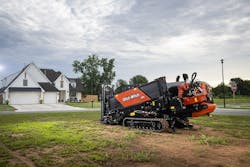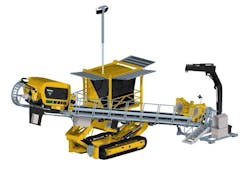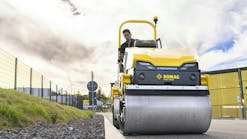Horizontal directional drill (HDD) giants Ditch Witch and Vermeer both report a strong market for directional drills and continue to invest in technology for their customer bases, including dual rod technology, commonality of electronics and controls, and telematics.
Horizontal directional drills are a significant investment, and as with virtually all equipment that engages the ground, sound choices and proper maintenance should produce years of service. One of the first things managers should consider is the nature of the work ahead.
“Before investing in a new drill, customers should first identify required capabilities and needs on future job sites,” says Jeff Davis, HDD product manager for Ditch Witch. “By understanding the relevant applications and ground conditions, customers can clearly communicate their rig expectations to dealership sales reps.”
Tod Michael, cutting edge business unit manager for Vermeer, says that choosing the right size directional drill can be a challenge because contractors will often have to manage multiple installations for multiple clients in multiple locations—all with varying ground conditions.
“The model that worked yesterday may not be the right one for the next project,” Michael says.
He recommends managers review four factors to narrow their HDD search: bore specifications, job site conditions, transportability, and fleet preference.
“When comparing the work your crews spend the bulk of their time on, what are the bore profile averages?” Michael says. “Where are your crews working, and what are the ground conditions like?”
For transportability, Michael recommends asking what else is being sent to the job with the crew, and what size trucks and trailers are being used to move it all there.
Finally, on fleet preference, answer how many crews will be running and whether or not there is a desire to standardize fleets or expand their capability range.
Total cost of ownership for directional drills
Once in the fleet, the challenge for HDD owners and operators is to keep operating costs down. OEMs have incorporated features to make that easier to do, particularly in the maintenance arena.
“Following best practices and conducting routine maintenance are two important factors that will help keep operating costs down over the long run,” Davis says.
“This will not only keep machines functioning at high levels, but also prevent costly downtime,” Davis continues. “To make this process seamless, manufacturers
like Ditch Witch design machines with contractor simplicity in mind. For example, Ditch Witch drills are prepackaged with intuitively located service points, easy-to-use manuals, and quick proper tooling guidelines, which makes HDD preventative care and maintenance straightforward.”
Vermeer’s Michael says training operators and crews is important to the cost-management mix.
“As with any piece of equipment, making sure operators are properly trained and following the manufacturer’s recommended service intervals is an effective way to help control operating costs,” Michael says. “Also, using tooling and the adequate volume drilling fluid will help keep drills working efficiently.”
Both major HDD manufacturers continue to add technology that can help reduce costs, including dual rod machines, integrated electronics, and of course, telematics.
Vermeer has 18 models in its North American horizontal directional drill product line. Its latest offering is the D23x30DR S3 Navigator.
Above: Vermeer has acquired electric-powered directional drill and fluid systems technology from Normag and aims to introduce the technology in Europe late 2021.
“It integrates dual rod technology into a compact machine designed to efficiently maneuver through rock in congested cities, busy neighborhoods, or tight job sites,” Michael says. He points to the unit’s narrow footprint and weight of 16,500 pounds as being well suited for fiber, electrical, gas, and water installation in hard rock and other difficult ground conditions.
“The unit’s Firestick drill rod gives operators up to 7 percent downhole steerability,” Michael says. “The D23x30DR S3 drill’s threaded outer rod has a rotational torque of 3,000 lb.-ft., and its hex inner rod delivers up to 800 lb.-ft. It’s powered by a Deutz TCD3.6L4 diesel engine.”
The company also has another dual rod machine, the D40x55DR S3. It is powered by a 140-horsepower John Deere engine and serves up 40,000 pounds of thrust/pullback and 5,500 lb.-ft. of rotational torque. It has 500 feet of onboard rod-carrying capacity.
Ditch Witch’s Davis says technology also has to address the labor shortage through increased commonality and simplicity designed to help operators.
“The HDD industry is currently facing a workforce shortage, while simultaneously facing a market with booming demand for HDD work,” Davis says. “However, advancements and innovations in HDD technology are on the rise, and manufacturers are putting their resources into solving the demand for qualified workers through evolving technology.
“One recent example is integrating electronics on machines to ease operation and maintain commonality across drills for simplified training; another is the adoption of telematics to increase job-site efficiencies,” Davis says.
How will directional drills improve?
Davis sees the future of HDDs including increased precision and even more compact drills.
“Operator proficiency and advanced equipment will be even more critical than it is today for future HDD projects,” Davis says. “Especially as underground environments become more crowded, precision in working in tight spaces will become an imperative skill. And, there will be an increased need for more compact directional drills to help operators stay efficient and nimble on these tight job sites.”
Electric-powered equipment has been a hot topic of late, and the HDD category will also see electric product development.
“It will have a part in the HDD sector soon,” Michael predicts. “Vermeer acquired electric-powered HDD and fluid systems from Normag in late 2020 and is working to bring new electric HDD product offerings to market soon. This type of technology will help operators better control their costs of operations and work site impacts through reduced fuel use, near-zero emissions, limited noise, and an overall smaller rig footprint.”
How has Covid affected directional drill market
Both Ditch Witch and Vermeer cite the Covid-19 pandemic as contributing to current HDD market conditions. Fiber and 5G are playing the most prominent roles.
“Fiber installation is, and will continue to be, one of the key drivers of the HDD market,” Davis says. “Amid the pandemic, many companies and individuals had to operate remotely, and reliable high-speed internet and 5G became more important than ever before. To accommodate these needs, the demand for fiber installation and broadband build-out increased—and will continue to increase—to help facilitate work, school, and entertainment. This is especially true in rural areas that haven’t had a robust fiber infrastructure in the past.”
Michael agrees that fiber installation remains a big driver.
“Contractors installing fiber have been working nonstop since before the pandemic, and there is an even higher demand now,” Michael says. “While much of the work is focused on expanding 5G services in dense population areas, we’re also seeing many states and local communities fund faster data connection speeds to rural areas due to limitations realized during the pandemic. Many of those projects are just beginning, and there is a lot of work to do.”
Aging infrastructure is also a factor. Gas service and distribution could see a boost, with old lines needing replacement.
“At the current rate of replacement, it appears there will be several years of work in this area of the market,” Michael says. “Also, in many locations, there is a push to move electric power transmission and services underground to make the network more reliable, as well as to protect from storms and wildfires.”
Oil and gas may be another story, according to Michael. “We did see some slowdown in the oil and gas market during the pandemic because everyone was staying home and not driving. This market will continue to be a challenge with some of the early decisions made by the new administration.”






